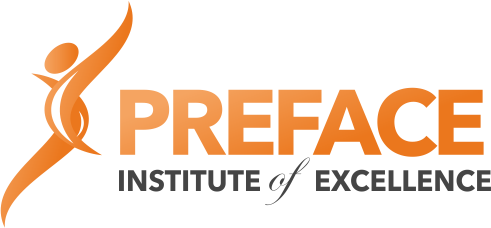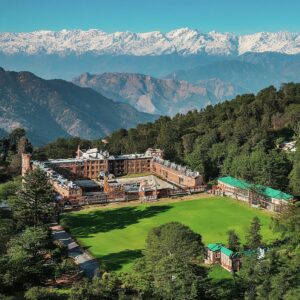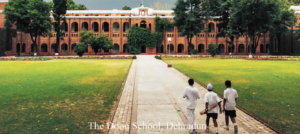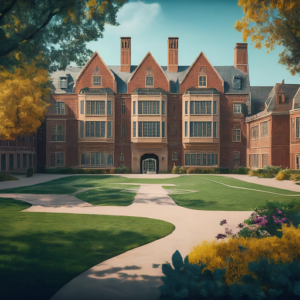Kodaikanal International School (KIS) – A Paradise of Education Amidst Nature
Introduction
Nestled amidst the pristine beauty of the Palani Hills in Tamil Nadu, Kodaikanal International School (KIS) has been a beacon of educational excellence in India for over a century. With a sprawling 43-acre campus that offers an immersive experience in nature, state-of-the-art facilities, a remarkable student-staff ratio of 7:1, and a deep commitment to the International Baccalaureate (IB) programs, KIS stands as an exemplary institution that nurtures young minds and shapes global citizens.
Campus and Facilities
KIS’s campus is nothing short of paradise. The school’s location in the Palani Hills provides a unique and breathtaking backdrop for education. The sprawling 43-acre campus is a lush green oasis, surrounded by the pristine air of the Western Ghats. Students at KIS are not just provided with an education; they are enveloped by an environment that stimulates learning and personal growth.
The campus is equipped with state-of-the-art facilities that cater to every aspect of a student’s development. Modern classrooms create a conducive environment for academic excellence, well-equipped laboratories foster scientific exploration, and a world-class library nourishes the love for reading and research. Additionally, dedicated sports facilities ensure that physical education and extracurricular activities are well-supported.
One of KIS’s most notable features is its remarkable student-staff ratio of 7:1. This low ratio fosters a close-knit and supportive community, where each student receives personalized attention and guidance. It allows teachers to tailor their teaching methods to cater to the unique needs of each student, thereby promoting holistic development.
Educational Philosophy
KIS’s educational philosophy is deeply rooted in the International Baccalaureate (IB) programs, including the Primary Years Programme (PYP), Middle Years Programme (MYP), and Diploma Programme (DP). The school is dedicated to nurturing inquisitive minds and shaping global citizens who not only excel academically but also possess a profound sense of empathy and a commitment to making a positive impact on the world.
The IB programs at KIS provide a robust framework that encourages students to become critical thinkers, effective communicators, and lifelong learners. Emphasizing inquiry-based learning, these programs cultivate curiosity and independent thinking. With a strong focus on international-mindedness, KIS prepares students to thrive in an interconnected and culturally diverse world.
Faculty and Staff
At the heart of KIS’s success is its dedicated and highly qualified faculty and staff. The teaching staff at KIS boasts exceptional academic credentials and a genuine passion for education. Their unwavering commitment to the school’s philosophy, along with their ability to inspire and guide students, plays a pivotal role in shaping the institution’s culture of excellence. Administrators and support staff also contribute significantly to the smooth functioning of the school, ensuring a nurturing and productive learning environment.
Extracurricular Activities
KIS places a strong emphasis on extracurricular activities, recognizing them as an integral part of a well-rounded education. The school offers a wide range of clubs and activities, catering to diverse interests. These activities have been instrumental in earning KIS recognition from esteemed organizations like the National Honor Society (NHS) and the Association for Supervision and Curriculum Development (ASCD).
Students at KIS are encouraged to explore their passions and talents in various fields, including music, arts, sports, and community service. These activities not only enrich their lives but also contribute to their personal growth and development as responsible global citizens.
Student Life
Life at KIS is a harmonious blend of academic rigor and a supportive, nurturing environment. Students are empowered to take ownership of their learning journey and explore their unique interests. The international composition of the student body promotes cultural diversity, encouraging students to broaden their horizons and foster cross-cultural understanding.
The school’s unwavering commitment to service learning instills a profound sense of social responsibility in students. They actively engage in community service projects, contributing to the welfare of the local community and beyond. KIS students graduate not only academically prepared but also with a strong sense of civic duty and a desire to make a positive impact on the world.
Notable Achievements
Kodaikanal International School has consistently achieved remarkable results in IB and SAT examinations, consistently surpassing world averages. This exceptional academic performance underscores the school’s commitment to excellence in education and its ability to prepare students for success on the global stage.
The school’s esteemed alumni have gone on to excel in various fields, making significant contributions to society. They attribute their success to KIS for nurturing their talents, instilling a sense of purpose, and preparing them to thrive in an increasingly interconnected world.
Historical Background
Origins (1890–1919)
The roots of Kodaikanal International School can be traced back to the late 19th century when there was a pressing need for an English-medium school in South India. The burgeoning Christian missionary community in the region sought a hill-station school to provide a refuge from tropical diseases while fostering a conducive atmosphere for learning.
In 1900, Margaret Eddy, visiting her missionary son Sherwood in Batlagundu, recognized this need and took the initiative to establish a school. She convened the first Kodaikanal Conference in June 1900, forming a committee tasked with finding teachers and suitable premises for the school.
With Mrs. Eddy’s leadership, “Highclerc School” opened its doors to students on July 1, 1901, at the Highclerc Hotel. However, due to rising rent costs, the school later relocated to Rock Cottage and Central House. In 1905, Mrs. Eddy’s dedication led her to purchase The Highclerc Hotel along with 3.5 acres of land, securing the school’s permanent location. Mrs. Eddy served as the school’s principal without compensation until 1905 when she had to return to the United States due to illness.
Development (1920–1959)
Substantial growth of KIS began in the late 1920s with land acquisitions that provided dormitory accommodations and facilities for the expanding student body. By 1930, the school had transformed into a high school catering to preschool through grade twelve. In 1944, Dayavu Dhanapal became the first Indian woman staff member at KIS.
Internationalization (1960–1989)
The 1960s marked a new era for the school, characterized by revolutionary social changes. In 1960, Herb Krause assumed the role of principal and aimed to open the school to students of all nationalities and religions, moving away from its traditional American Christian image. In 1968, the school received accreditation from the Middle States Association of Colleges and Schools due to its commitment to curriculum improvement.
The changing global landscape also influenced KIS, leading to debates about religious freedom and the school’s mission. The student body diversified as international companies endowed grants, creating a more cosmopolitan environment.
In 1975, KIS became the first school in India to adopt the International Baccalaureate Diploma Program. This marked a significant milestone in the school’s history. The KIS High School Diploma was also recognized by the All India University Board in 1981.
Recent History (1990–Present)
In 1994, “Project Design” from 1974 was revised and renamed “Design ’94,” serving as the guiding document for the school’s mission and objectives. KIS officially adopted the IB Middle Years Program curriculum in 2006, further enhancing its commitment to international education.
Today, KIS offers all three programs of the IB Curriculum – the PYP, MYP, and the IBDP, as well as the KIS High School Diploma. With a diverse student body and faculty from over 25 nationalities and every continent, KIS continues to thrive in an interconnected world.
Alumni
KIS boasts an impressive list of alumni who have made significant contributions to various fields. Notable alumni include :
| Name | Birth Year | Death Year | Occupation |
|---|---|---|---|
| William D. Coleman | 1915 | 2001 | Pastor |
| Robert F. Goheen | 1919 | 2008 | Academic and Ambassador |
| Romulus Whitaker | 1943 | – | Conservationist |
| Michael Aung-Thwin | 1946 | 2021 | Burmese Historian and Academic |
| Stephen R. Donaldson | 1947 | – | American Novelist |
| S. Ashok Kumar | 1947 | 2000 | Judge |
| Chris Granner | 1957 | – | Composer and Sound Designer |
| Chris Van Hollen | 1959 | – | American Politician |
| Ashok Kamte | 1965 | – | IPS Officer (Maharashtra Cadre) |
| Sajeeb Wazed | 1971 | – | Bangladeshi Businessman and Politician |
| Ram Kapoor | 1973 | – | Actor |
| Aatish Taseer | 1980 | – | Writer |
| Esha Deol | 1981 | – | Actor and Model |
| Pawo Choyning Dorji | 1983 | – | Bhutanese Filmmaker and Photographer |
| Taaha Shah | 1987 | – | Actor and Model |
| Eugene Irschick | 1934 | – | Professor Emeritus, UC Berkeley |
| Arjun Rampal | 1972 | – | Indian Actor, Model, Film Producer, and Television Personality |
| Zayed Khan | 1980 | – | Former Indian Actor and Producer |
| Kai Bird | 1951 | – | American Author and Columnist |
Extracurricular Activities
KIS places a strong emphasis on extracurricular activities, enriching students’ lives and fostering personal growth. The KIS Robotics Team, for instance, competes annually in regional and international robotics competitions, showcasing the school’s commitment to STEM education.
Social awareness and community service have been integral to KIS since the 1960s. Initiatives like the Social Experience program (SoEx) engage students in activities such as working in orphanages, supporting local schools, and participating in community development projects. The Student Council (StudCo) and Middle-school Council (MidCo) provide students with opportunities to actively engage in school governance, ensuring their voices are heard.
Financial Aid
KIS is committed to providing opportunities for scholarship students through its financial aid program, making quality education accessible to a diverse student body.
Campus Facilities
KIS boasts two distinct academic campuses – The Highclerc Campus for high school (grades 9–12) and Ganga Campus for elementary school (grades P-5) and middle school (grades 6–8). Additionally, the Wilderness Camp, located in a forest near the village of Poondi, offers outdoor education programs for students. Highclerc Campus offers stunning views of Kodaikanal Lake and the town.
Partnership and Student Exchange
KIS has established partnerships and student exchange programs with institutions in Germany, France, and Italy. These programs provide students with the opportunity to experience different cultures and educational systems, further enhancing their global perspective.
Conclusion
Kodaikanal International School’s century-long journey from its modest beginnings to its present status as an internationally acclaimed institution is a testament to its unwavering commitment to excellence in international education. With a breathtaking campus, world-class facilities, a rich educational philosophy, and a nurturing faculty, KIS continues to be a shining example of what a school can achieve.
As KIS charts its course into the future, it remains dedicated to shaping the leaders, thinkers, and visionaries of tomorrow. It is an institution that not only imparts knowledge but also instills values, preparing students to succeed not just academically, but as responsible and empathetic global citizens ready to make a positive impact on the world.







